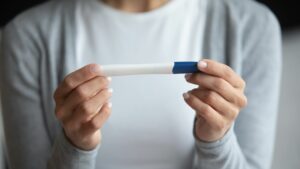Low AMH does not mean there is no hope.
AMH, or anti-Müllerian hormone, is one of the tests in a fertility work-up. This hormone is produced by the cells in the ovary and is one of the markers for ovarian reserve or function. Ovarian reserve and age are inversely related: as a woman ages, her ovarian reserve decreases. The AMH level is ideally between 1 and 2. Based on a previous study, we know that we can expect diminished ovarian reserve and low response if the AMH is less than 0.6 ng/mL. An AMH test result of 0.16 is considered “ultralow.”
We hope to see a good AMH result; low AMH levels can portend difficulty in trying to conceive. We also need to look at the antral follicle count to see how many follicles there are. Even if the AMH is less than 1 and the numbers of the eggs are low, the pregnancy rates can be perfectly reasonable, and in fact parallel to those who have better AMH levels.
Spontaneous pregnancies and high-frequency intercourse as good medicine
Marina and her husband tried in vitro fertilization (IVF), but it did not work. The couple went on vacation, and pregnancy happened – after three years of trying. We met their sweet little Matthew recently for the first time.
Always remember that IVF improves month-to-month pregnancy rates, but very few people are totally infertile. Infertility is a relative concept. Subfertility is really more appropriate as long as the tubes are not blocked and there are sperm present.
There are spontaneous pregnancies when otherwise we might think, based on the past, that it could not happen. Every year we have happy surprises with patients who are trying, trying and trying and finally the right egg gets to the right place and Mother Nature comes through.
But we cannot really count on this. We know that patients with unexplained infertility, for example, who have been trying to conceive for five years have a chance of conception which might be under 5 percent each month compared with 20 percent for couples their age without a history of infertility.
The procedures such as intrauterine insemination (IUI) and IVF are devised to try to improve their chances as much as possible. IUI can get the pregnancy rates up to the higher teens for some couples. With any treatment, pregnancy rates can vary according to the age of the woman.
Our patient Marina conceived on vacation, and that is not uncommon. Why would that be true? It is because people have more sex on vacation than they do when they are not on vacation. So, high-frequency intercourse is a good solution, it is good medicine, and we highly recommend it.
What a recent study revealed about ultralow AMH patients with Conventional IVF
Recently, we had a patient in her early 40s come in for a second opinion. She was told by another center that because her AMH was low, she only had a 2 percent chance of conceiving and they would not allow her to try in vitro fertilization (IVF) with her own eggs. If you have a low AMH value of 0.1, you do not have to move immediately to an egg donor.
David Seifer of Oregon Health and Science University and several colleagues including our friend, Valerie Baker, from Stanford, used the Society for Assisted Reproductive Technology (SART) national database of over 5,000 Standard IVF cycles in a recent study that sheds much light on what a woman can expect if she has ultralow AMH. The average age of these patients was 39.4.
In this retrospective survey of the national database, the ultralow AMH test result of 0.16 ng/mL was used as criteria for entry into the study. Also, while the follicle-stimulating hormone (FSH) level ideally is less than 10, this group had an FSH average of 15.3 mIU/mL (milli-international units per milliliter), another prognostic indicator for poor results.
First to note, the cycle cancellation rate was 55 percent. This is to be expected with this patient population. If a patient goes through stimulation and finds out that she is getting only one or two follicles for a Standard IVF cycle, it is frequently cancelled.
Those patients who did have egg retrievals had, on average, four eggs retrieved. About 5 percent had zero eggs retrieved. The clinical pregnancy rates per cycle start were 13 percent. More surprisingly, the pregnancy rates were 22 percent per retrieval and 28 percent per transfer. So, while some patients dropped out because they had no embryos develop, the pregnancy rates were decent. Ultimately, live births are the only true measure of success, and this group of patients had 16 percent success rate per retrieval and 20 percent for transfer.
Since the average age in this study was 39.4, we can assume that half of the patients were younger than 39. Young patients with ultralow or low AMH with diminished ovarian reserve have higher pregnancy rates than the 44 year olds with the same AMH. The age-matched patients in the SART database who had normal anti-Müllerian hormone values had double the success rate.
This was the largest study of its kind and was the first study to really analyze this subset of ultralow AMH potential patients who face the possibility of poor response with Standard IVF. Other studies have shown pregnancy rates in similar populations of IVF patients, with live birth rates of 5-6 percent.
Aboulghar, a distinguished practitioner, and colleagues in Egypt, completed a study of patients under age 40. The pregnancy rates were the same when the anti-Müllerian hormone was under 1 as they were when it was over 1.
Many of our patients, when faced with ultralow or low AMH, are choosing to do Natural IVF or Mini Stim IVF instead of Standard IVF or donor eggs. These are low cost options, including much lower medication costs.
Even if the AMH is rock-bottom low, we hope you will consider contacting us for more information about how we help women with low AMH to have a baby.






